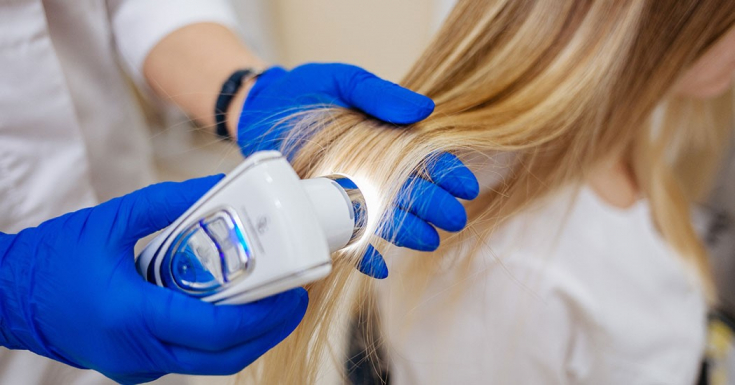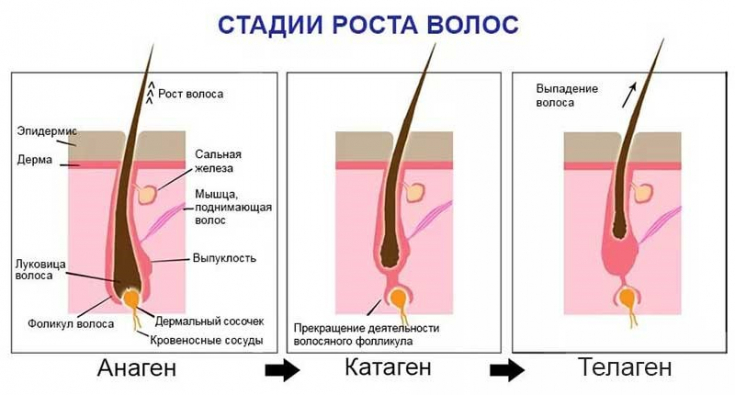The problem of hair loss is one of the most urgent in modern trichology due to the increase in the incidence of this dermatosis, resistance to various methods of treatment, and a significant negative impact of clinical manifestations on the quality of life of patients. Particular attention today is paid to the genetic aspects of the disease, including the role of these factors in the ratio of female and male sex hormones, as well as the impact of relevant disorders on the onset and course of the disease.
Read about the stages of growth and the mechanism of hair loss, as well as topical agents for the treatment of pathology, at estet-portal.com
- Association between hair loss and sex hormone concentrations
- Physiological hair loss and its criteria
- Ditranol and minoxidil in the treatment of hair loss
The relationship between hair loss and the concentration of sex hormones
According to Professor L. D. Kalyuzhnaya, it must be emphasized that each hair has a growth cycle independent of the surrounding hair. The process of hair growth and change consists of 3 phases: anagen, catagen and telogen.
Follow us on Instagram!
Personally, the growth period itself is called the anagen phase. In the absence of pathology on the scalp, where most of the hair is long and thick, the duration of the anagen period is from 3 to 7 years, with individual characteristics. The longer the anagen phase, the longer women's hair can reach a certain length. The child has a shorter anagen period, which contributes to the formation of vellus hair on the scalp.
Read also: The importance of trichoscopy in dermatological practice
is manifested. Hair hypertrophies, axillary and pubic hair appear, and in men, the quantity and quality of hair on the chest and back increases. Such hair is called androgen. Following the anagen, the catagen phase (departure of the hair from the hair papilla) lasts 2-3 weeks, and the resting (telogen) phase lasts approximately 100 days. Metabolically phase telogen is inactive. Physiological hair loss and its criteria
There are approximately 100,000 hairs on the scalp. During a particular period of time, 5-20% of the hair is in the telogen phase, 80-95% is in the anagen phase, and 1% is in the catagen phase.
It follows from this that 50-100 hairs fall out every day. Normally, the amount of telogen hair varies in each person, and these fluctuations are characteristic of individual areas of the scalp. In telogen men, there is more hair in the frontal zone and on the crown, the anagen phase is also reduced there, so the loss in these zones is somewhat accelerated and normal.

Topical corticosteroids (CS) have a level of evidence of 2+ in the treatment of hair loss. Strong corticosteroids are widely used to treat alopecia, but the evidence for their effectiveness is limited.
The highest efficiency of their use is confirmed in the autoimmune mechanism of hair loss or against the background of systemic diseases of the connective tissue. In a study using 0.025% deoxymethasone cream, in 70 patients with alopecia areata, more patients treated with CS noticed a non-significant improvement compared to placebo.
Read also:Fibroblast growth factors and peptides to activate hair growth In a study with clobetasol propionate 0.05% foam, in 34 patients with moderate to severe alopecia areata, selective treatment was given on one side of the scalp and an inert agent was applied to the other side.
After 12 weeks of treatment, at least 50% increase in hair growthwas observed in more areas of the scalp where clobetasol was applied. The use of clobetasol propionate under an occlusive dressing is an effective treatment in patients with alopecia areata. Follow our updates on
Facebook! It is important to remember that folliculitis is a common
side effect of treatment with potent topical glucocorticosteroids.In a study from Saudi Arabia, 62% of
used intralesional injections of triamcinolone acetonide to treat hair loss. Many of the patients achieved full hair regrowth with monthly injections, and the response was better in those who had less than 5 patches less than 3 cm in diameter. This method is most suitable for the treatment of minor patchy hair loss and for pharmacologically sensitive to preparation plots. Ditranol and minoxidil in the treatment of hair loss
There are a small number of case reports of the use of dithranol or other irritants in the treatment of alopecia areata. Lack of control makes it impossible to fully evaluate the results, but only a small proportion of patients achieve a cosmetically sufficient result (level of evidence 3).
In one open-label study, 18% of patients with alopecia areata achieved cosmetically significant hair growth.

Published data indicate that dithranol has to be used
often enough to produce a reaction, which in turn causes severe irritation to achieve an effect.Hair coloring limits its use in a certain category of patients.
Read also:How to stop hair aging: treatment of age-related alopecia An early double-blind study showed a significantly higher rate of hair regrowth in alopecia in patients
treated with topical minoxidil 1% compared with placebo (LE: 2).The following control studies in patients with severe alopecia in which 1% or 5% minoxidil confirmed these results: treatment response was shown in those patients treated topically with 5% minoxidil. More useful information on our
YouTube channel:






